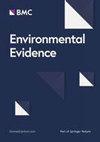Effects of public policy interventions for environmentally sustainable food consumption: a systematic map of available evidence
IF 5.2
4区 环境科学与生态学
Q2 ENVIRONMENTAL SCIENCES
引用次数: 0
Abstract
The global food system is inflicting substantial environmental harm, necessitating a shift towards more environmentally sustainable food consumption practices. Policy interventions, for example, information campaigns, taxes and subsidies and changes in the choice context are essential to stimulate sustainable change, but their effectiveness in achieving environmental goals remains inadequately understood. Existing literature lacks a comprehensive synthesis of evidence on the role of public policies in promoting sustainable food consumption. Our systematic map addressed this gap by collecting and categorising research evidence on public policy interventions aimed at establishing environmentally sustainable food consumption patterns, in order to answer the primary research question: What evidence exists on the effects of public policy interventions for achieving environmentally sustainable food consumption? Searches for relevant records (in English) were performed in WoS, Scopus, ASSIA, ProQuest Dissertation and Theses, EconLit, Google Scholar and in bibliographies of relevant reviews. A grey literature search was also performed on 28 specialist websites (searches were made in the original language of the webpages and publications in English, Swedish, Danish and Norwegian were eligible) and Google Scholar (search in English). Screening was performed at title/abstract and full-text levels, with machine learning-aided priority screening at title/abstract level. Eligibility criteria encompassed settings, interventions (public policies on sustainable food consumption), target groups and outcomes. No critical appraisal of study validity was conducted. Data coding covered bibliographic details, study characteristics, intervention types and outcomes. Evidence was categorised into intervention types and subcategories. Visual representation utilised bar plots, diagrams, heatmaps and an evidence atlas. This produced a comprehensive overview of effects of public policy interventions on sustainable food consumption patterns. The evidence base included 227 articles (267 interventions), with 92% of studies in high-income countries and only 4% in low-income countries. Quantitative studies dominated (83%), followed by mixed methods (16%) and qualitative studies (1%). Most interventions were information-based and 50% of reviewed studies looked at labels. Information campaigns/education interventions constituted 10% of the sample, and menu design changes and restriction/editing of choice context 8% each. Market-based interventions represented 13% of total interventions, of which two-thirds were taxes. Administrative interventions were rare (< 1%). Proxies for environmental impact (85%) were more frequent outcome measures than direct impacts (15%). Animal-source food consumption was commonly used (19%) for effects of interventions on, for example, greenhouse gas emissions. Most studies used stated preferences (61%) to evaluate interventions. The literature assessing policies for sustainable food consumption is dominated by studies on non-intrusive policy instruments; labels, information campaigns, menu design changes and editing choice contexts. There is a strong need for research on sustainable food policies to leave the lab and enter the real world, which will require support and cooperation of public and private sector stakeholders. Impact evaluations of large-scale interventions require scaling-up of available research funding and stronger multidisciplinary research, including collaborations with industry and other societal actors. Future research in this field should also go beyond the European and North American context, to obtain evidence on how to counteract increasing environmental pressures from food consumption worldwide.促进环境可持续食品消费的公共政策干预措施的效果:现有证据系统图
全球粮食系统正在对环境造成严重危害,因此有必要转向更具环境可持续性的粮食消费方式。政策干预措施,如宣传活动、税收和补贴以及选择环境的改变,对于促进可持续变化至关重要,但人们对这些措施在实现环境目标方面的效果仍缺乏充分了解。现有文献缺乏对公共政策在促进可持续食品消费方面的作用的全面综合证据。我们的系统地图针对这一空白,收集了旨在建立环境可持续食品消费模式的公共政策干预措施的研究证据,并对其进行了分类,以回答首要研究问题:在实现环境可持续粮食消费的公共政策干预效果方面有哪些证据?在 WoS、Scopus、ASSIA、ProQuest Dissertation and Theses、EconLit、Google Scholar 和相关评论的书目中搜索了相关记录(英文)。此外,还在 28 个专业网站上进行了灰色文献检索(以网页的原始语言进行检索,英语、瑞典语、丹麦语和挪威语的出版物均符合条件)和谷歌学术(以英语检索)。在标题/摘要和全文层面进行筛选,在标题/摘要层面进行机器学习辅助优先筛选。资格标准包括环境、干预措施(有关可持续食品消费的公共政策)、目标群体和结果。未对研究的有效性进行批判性评估。数据编码包括书目详情、研究特点、干预类型和结果。证据被分为干预类型和子类。利用条形图、图表、热图和证据图集进行可视化表达。这样就可以全面了解公共政策干预对可持续食品消费模式的影响。证据库包括 227 篇文章(267 项干预措施),其中 92% 的研究在高收入国家进行,只有 4% 的研究在低收入国家进行。定量研究占主导地位(83%),其次是混合方法研究(16%)和定性研究(1%)。大多数干预措施以信息为基础,50%的受审查研究关注标签。信息宣传/教育干预占样本的 10%,改变菜单设计和限制/编辑选择范围各占 8%。市场干预占总干预的 13%,其中三分之二是税收。行政干预很少见(< 1%)。环境影响的替代指标(85%)比直接影响(15%)更常用。动物源性食品消费通常(19%)用于衡量干预措施对温室气体排放等的影响。大多数研究使用陈述偏好(61%)来评估干预措施。评估可持续食品消费政策的文献主要是关于非侵入性政策工具的研究;标签、宣传活动、菜单设计变化和编辑选择环境。可持续食品政策研究亟需走出实验室,进入现实世界,这将需要公共和私营部门利益相关者的支持与合作。要对大规模干预措施的影响进行评估,就必须扩大现有研究资金的规模,加强多学科研究,包括与产业界和其他社会参与者开展合作。今后在这一领域的研究也应超越欧洲和北美的范围,以获得如何应对全球食品消费所带来的日益增长的环境压力的证据。
本文章由计算机程序翻译,如有差异,请以英文原文为准。
求助全文
约1分钟内获得全文
求助全文
来源期刊

Environmental Evidence
Environmental Science-Management, Monitoring, Policy and Law
CiteScore
6.10
自引率
18.20%
发文量
36
审稿时长
17 weeks
期刊介绍:
Environmental Evidence is the journal of the Collaboration for Environmental Evidence (CEE). The Journal facilitates rapid publication of evidence syntheses, in the form of Systematic Reviews and Maps conducted to CEE Guidelines and Standards. We focus on the effectiveness of environmental management interventions and the impact of human activities on the environment. Our scope covers all forms of environmental management and human impacts and therefore spans the natural and social sciences. Subjects include water security, agriculture, food security, forestry, fisheries, natural resource management, biodiversity conservation, climate change, ecosystem services, pollution, invasive species, environment and human wellbeing, sustainable energy use, soil management, environmental legislation, environmental education.
 求助内容:
求助内容: 应助结果提醒方式:
应助结果提醒方式:


